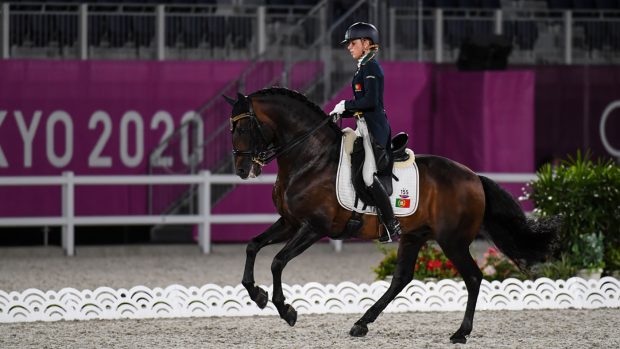“I’ve had better horses for competition, but if I could have only one horse to be my best friend it would be a Lusitano,” says George Bowman snr, one of Britain’s top carriage drivers, who has been a fan of Lusitano horses for many years now.
The Lusitano is bold, clever and handsome, and it is generally accepted that it makes the perfect riding horse, but is it the perfect competition horse? George thinks probably not. He enjoys riding and training Lusitanos in-hand, as well as using them for driving, but admits that he wouldn’t choose them as his competition team.
“Lusitanos are good all-rounders and enjoyable to work with because they’re so intelligent. I have found them good at the dressage element of driving, but when they go across country they get over-enthusiastic, start firing on five cylinders and take over — they react too quickly.”
For pleasure
Probably one of the best known aficionados of Lusitanos is Sylvia Loch, who, with her late husband Lord Loch, was the first to import Lusitanos into the country in numbers.
“They’re an exceptional pleasure horse and are built to produce the collection for advanced dressage, but they can easily be written off at the lower levels because, to the uninitiated eye, they can look tight in the back,” she says.
“However, a horse needs strong loins and tremendous tension in the hindquarters to hold collection and, for this reason, Lusitanos don’t have the looseness of young Thoroughbred or warmblood horses, which find the opposite of collection — lengthened strides — so much easier.
“The Lusitano’s balance is very different to that of a Thoroughbred or warmblood, their natural carriage is up and back, and their centre of gravity further back; they’re naturally collected horses.
“In my experience pure-bred Lusitanos make better show jumpers than eventers because, with their short-coupled bodies, they have great stamina and are able to offer short, fast bursts of energy, but are not built to cover the ground over distance.”
Dressage success
Seasoned dressage trainer and rider Andrew Murphy, who has competed the Lusitano Jalisco IV for the past seven years from elementary level up to grand prix, agrees.
“He’s been a rewarding horse to train,” says Andrew. “He’s such a quick thinker and offers so much. Unfortunately, ‘so much’ is sometimes ‘too much’ and he takes over in the test to put in some impromptu tempi changes.”
The Portuguese do not breed the Lusitano specifically as a competition horse. The breed’s original purpose was as a warhorse and later for bullfighting. Performance in the bullring is one of the most important factors in the breeding and selection process of the Lusitano, so the characteristics of the breed have been preserved.
The horses are noble, brave, powerful and quick, with compact conformation. They have a well set-on head and neck, strong loins and a well-developed second thigh — all attributes sought in the modern sports horse.
Lusitanos range from the larger, heavier-set, Spanish-looking ones, to the more traditional, finer, agile, almost ethereal and “hotter” Veiga type. Breeders often keep their stock pure for a particular discipline, such as Veiga horses for bullfighting, but they also cross them to take the best qualities from each line and produce more of an all-rounder.
Sport horses
The eye-catching Novilheiro, who  formed a formidable partnership with John Whitaker and went to grade A in one season, is probably the best known pure-bred Lusitano show jumping stallion. Bred in Portugal by Manuel Veiga at his stud in Golega, Novilheiro was out of a Veiga mare by an Andrade stallion.
formed a formidable partnership with John Whitaker and went to grade A in one season, is probably the best known pure-bred Lusitano show jumping stallion. Bred in Portugal by Manuel Veiga at his stud in Golega, Novilheiro was out of a Veiga mare by an Andrade stallion.
Johanna Vardon, who stood Novilheiro at her Meretown Stud in Shropshire, bred her own stallion, Crown Cornelian, by Novilheiro out of a sport horse mare. Cornelian went on to sire many talented jumping horses, including Anne Burnet’s The Tourmaline Rose (right), ridden by Pippa Funnell to win Hickstead’s Eventers’ Grand Prix three out of the four times they contested it.
He also sired Crown Tungsten, who has been with John Whitaker and is now with young rider Ryan Prater; the stallion Crown Rhodonite, who is on the BSJA Accenture young rider squad with Emma Shaw, and Crown Derby, who is on the junior event team.
“Pure-bred Lusitanos are brilliant for bullfighting and classical dressage, but crossed with a Thoroughbred they become the ultimate sport horse,” says Johanna.
Multi-talented
Englishwoman Zoe Harrison recently took over the running of the Veiga stud in Golega. She persuaded her mother, Christine, to buy a Lusitano stallion and the pair now hunts regularly with the Devon and Somerset Staghounds. Christine’s sister, Veronica Ward, also hunts a Lusitano stallion.
She says: “I’ve been a fan of the breed for a long time. I owned a Lusitano mare more than 20 years ago and she was a wonderful all-rounder and a capable jumping horse, taking part in riding club eventing and often giving the lead over fences out hunting.”
Another breeding stallion who is making his mark on both the dressage and showing scene is O Conquistador, or “Luxo”, who stands at Helen Edmonds’s Broomford Stud. The champion stallion at the Lisbon show in 1996, Luxo is also a gold medal-winner, which means that he holds the highest grading level. His other successes include supreme champion at the breed show and best Lusitano stallion at Royal Windsor in 2002.
He has done well in dressage up to advanced medium and Helen is aiming to qualify him for the national championships at prix st georges later this year. “Lusitanos are a fantastic, intelligent, athletic breed and the most comfortable horses I have ever sat on,” she says.
The following websites offer more information on the breed:



